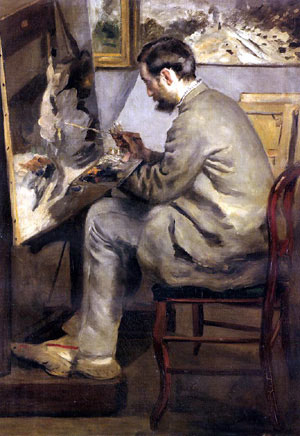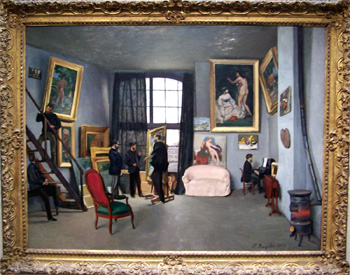| |
| |

Frederic Bazille was born in a Protestant
family of the upper middle class of Montpellier in
the south of France. His father was a rich landowner and wine grower as
well as a notable of the city of Montpellier .
In 1862, he comes to Paris to continue with his studies
of medicine, while spending most of his time at the School of Fine Arts
to paint in the Workshop of Charles Gleyre, where he
forms a friendship with Monet, Renoir,
and Sisley.
His artistic vocation went back to his meeting with a
friend of his parents, the art collector and patron from Montpellier
Alfred Bruyas , who influenced Courbet as well as the
Impressionists. At his beginnings Bazille's painting will be inspired
by the works of Courbet and Manet.
|
|

|
Bazille
painting "the heron"
1867
by RENOIR
Musée d'Orsay, Paris

|
In Easter of 1863, he stays with Monet at Chailly in the
forest of Fontainebleau in order to experiment with open air painting.
|

The pink dress
1864
Musée d'Orsay, Paris
|
|
In 1864 he rents an artist studio in the street of
Vaugirard and stays in Honfleur with Monet in June
where he meets Boudin and Jongkind.
On his return to Paris, he gets to know that he has failed his
examinations of medicine and obtains his parents' permission to totally
devote himself to painting.
In 1865 he shares with Monet, whom he helps financially,
a workshop in the street of Furstenberg.
He submits two works to the Official Salon of 1866,
"Girl at the piano " and "Still life with fish", the
latter being accepted.
Thereafter he will be regularly admitted to
exhibit to the Salon.
|
The same year, he shares with Renoir a new studio located in
Visconti street.
| |
Thereafter he will move in the district of Batignolles,
in the street de la Condamine, near the Café Guerbois
of which he had become a regular visitor.
It is in this new workshop that he executed in 1870 his
famous painting " Bazille's Studio, rue de la Condamine",
where one can see him presenting a new work at Manet
and Monet, whereas his friend Maître plays at the
piano and Zola discusses with Renoir.
This painting with an open composition
- where Manet himself painted the high silhouette of Bazille -
underlines the friendly and good working relationships
of the protagonists with no hierarchical order between them.
|
|

|
| |
|
Bazille's Studio, rue de la Condamine
1870
Musée
d'Orsay, Paris
|
Pissarro, Cézanne, and
sometimes Courbet, visited him in his successive studios. He was also
one of the rare persons able to face verbal arguments with erudite and
ironic painter Degas, showing of a clear
thinking and a realism which one can find in
his paintings.
|

Summer Scene
1869
Fogg Art Museum , Harvard
University
Cambridge, Ma. USA
|
|
|
The work of Bazille, stopped by his untimely death
during the war of 1870, shows new compositions developed with
audacity and diversity : open-air portraits with bottom
panoramic as in " The dress pink" 1864 or "
Village view of Castelnau-le-Lez " 1868 , scene of family as his
large painting "Family gathering" 1867
(152x230), scenes of plein-air such as "Summer scene" 1869
.
He particularly applied himself to combine figures
painting in open-air with an intense concentration on natural light .
|
|
Bazille voluntarily engaged, with enthusiasm, in the
regiment of the Zouaves just before the war of 1870. He was killed
while fighting at Beaune-la-Rolande (close to Orleans) on
November 28, 1870, at the age of 29.
|
|



